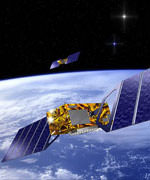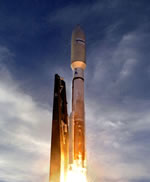
Image credit: ESA
The European Union announced on Thursday that China will play a role in the development of the Galileo constellation of satellites, which are designed to provide a similar solution as the US-based Global Positioning System. The exact commitments from China haven’t been detailed yet, but the two groups have set up a training, cooperation, and information centre for satellite navigation in China at Beijing University. Galileo will be built with 30 navigation satellites to provide complete global coverage – it’s expected to be fully operational by 2008.
Europe and China share a common interest in cooperating to bring the benefits of satellite navigation and Galileo in particular to transport, science, land management, disaster prevention and other user sectors.
Sharing research results, encouraging education, joint projects and industrial contacts are important means towards such goals.
In this context, the European Commission, the European Space Agency and the Chinese Ministry of Science and Technology have decided to establish a training, cooperation and information centre for satellite navigation in China. On the basis of bilateral discussions to date in the Europe-China Joint Technical Working Group, the decision has been taken to locate the centre at the renowned Beijing University.
The centre will be staffed initially by one or two experts supported by two administrative and technical assistants.
Mr F. Lamoureux, Director General for Energy and Transport at the European Commission, will inaugurate the centre together with Mr Shi Dinghuan, Secretary General of the Chinese Ministry of Science and echnology, at 11:00 on Friday 19 September in Beijing.
This will take place at the China-Europe Technical Training and Cooperation Centre, Room 323 ZhongGuanCun FangZheng Building, No 298, Chengfu Road, Haidian District (in front of the Beijing University East Gate).
The Galileo system will be built around 30 satellites (27 operational and three in reserve) stationed on three circular medium-Earth orbits at an altitude of 23 616 km and inclined at 56? to the equator. This configuration will provide excellent coverage of the entire planet. Two Galileo centres will be set up in Europe to control satellite operations and manage the navigation system.
Developed by ESA and the European Union on the basis of 50-50 cofinancing, Galileo will be a complete civil system, due to be operational from 2008, offering users in Europe, and throughout the world as well, a precise, secure satellite positioning service.
Original Source: ESA News Release






